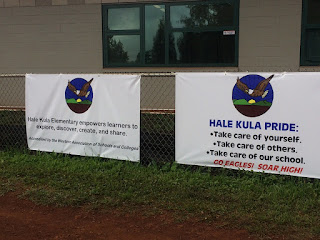I shared in an earlier post that I have a great staff; they take the initiative to do what needs to be done. We communicated via email or texts so I wasn't out of the loop as there were important things happening when I returned to school.
The first day back for teachers is something that is planned carefully because we set the stage for the whole school year. Mandatory trainings are part of that day; that is necessary but does not have to be painful. Our vice principals kept the teachers engaged with quick overviews and group activities to read, summarize, and share with the rest of the faculty. It helped to have chocolate to "reward" correct responses.
Sharing our school goals and focus for the year is an essential part of the first day back. Group discussions, sharing out, and having the opportunity to ask and answer tough questions really helped to improve our overall plans for the year. Now the challenge is to take the criteria we came up with as a group and to reflect so we can continue to improve.
This summer was especially busy with ongoing construction. Completing the classroom renovations was a major coup given two weeks less time to do everything. I sometimes felt like I was cracking the whip, making sure the subcontractors finished their jobs so our teachers could get back into their rooms to set up for the new school year. The contractor joked that I was like a mama bear protecting her little ones. I guess I'd rather be a mama bear than a another b word!
Yesterday, we celebrated the opening of the new classroom building with a Blessing and Open House. When the Governor and First Lady accepted the invitation to attend, the event took on a new level of importance. Thanks to all those who assisted with the planning, the day turned out great, and all of the guests were impressed with the new building. We had a chance to share our vision for our students and how the building would enhance teaching and learning through collaboration, project-based learning, the integration of technology, and having students explore, discover, create, and share.
Tomorrow, students return to school. We want them to be proud of the new classroom building and to commit to doing their part to take care of it. All of the "old" buildings have also been renovated and the campus looks so much brighter and cleaner with the new exterior paint and the new roofs. Our first task for our students will be to co-construct criteria on what it means to have "Hale Kula Pride: Take care of yourself. Take care of others. Take care of our school." I look forward to seeing what students come up with then it will be our job to make sure we are all doing our part to show Hale Kula Pride!
Ready or not, here they come! Looking forward to a great school year!
 |
| Our aloha dinner the night before returning home. |
 |
| Our new 10-classroom building |
 |
| The Governor and First Lady with our student greeters |
| We continue to focus on our vision and on reflecting Hale Kula Pride in our actions. |







